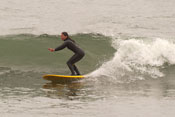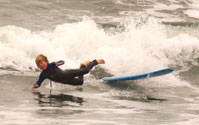|
|

The
Science of Surfing
page 3
Turning
Rocker
Examine the bottom of a surfboard and you will note that it curves
gently up at the tail and at the nose. This is called the bottom
rocker of the board. The rocker at the rear helps you to turn the
surfboard.

|
|
Look
at the path recorded in the water behind Lori, and you can
see she’s turning. Look at the board, and see that it’s
tilted to the right and to the rear. Lori is pressing down
with the toes of her rear foot to make the board turn.
|
Push on the Water
and It Pushes Back
You’re sliding down the face of a wave and notice that the
wave is breaking to your left and is peeling to the right. You want
to turn right. You shift your weight onto your back foot, then push
down with your heels or toes—whichever part of your foot is
on the right side. You’ve moved the force you exert on the
surfboard back and right from where it was in balance. The board
responds by rolling a bit to
the
right and pushing the right rail, or edge of the board, into the
wave, while the rocker at the tail of the board pushes on the water.
A person watching from the shore can see the water spray to the
left side of the board as you push the water out of the way. The
forces of the water on the curved bottom of the rear of the surfboard
cause the board to rotate to the right.
Turning Faster
If you are surfing with your legs bent into a crouch so deep that
you can put a hand out and touch the wave beside you, then in the
middle of a turn you can straighten your legs, accelerating your
body upward. This will push the board down into the water with a
force greater than gravity, and this extra force will make the board
turn faster.
|
Compare
how surfers navigate turns on a longboard and a shortboard.
Click the pictures to see video of a person riding.

|
|
The
shortboard surfer only needs to makes the smallest movements
to turn.
|

|
|
The
longboard surfer has to do much more of a dance to stay
afloat.
|
|
Longboard Versus Shortboard
Turns
Shortboards are short, with thin, pointed noses. Longboards are
long, with wide, rounded noses. If you pick up a short piece of
wood, a foot-long 2" x 4" for example, and try to twist
it rapidly side to side, you’ll find that it’s easy to
turn. But try to turn a three-foot-long piece, and your turning
motions slow down. The same is true for surfboards. A longer, heavier,
surfboard turns more slowly than a short, light one. Physicists
call the resistance of the board to rotation its moment of inertia.
Longboard Versus Shortboard Speeds
A longboard might be slower to turn than a shortboard, but it goes
faster when you are paddling it. A general rule for boats is that
longer boats have a higher maximum speed limit known as hull speed;
they go faster than shorter boats. The same rule applies to surfboards.
This is because a boat or a board makes its own waves as it moves
through the water. At the hull speed, the wave it makes is highest
at the front of the board and lowest at the rear, so the board is
always going uphill.
You can see the wave generated by the surfboard itself in the earlier
photo of the blonde surfer paddling out to sea. As she paddles faster,
the crest of the wave moves toward the back of the board. But a
board that is sliding across the surface of the water is not limited
by its hull speed. So when a shortboard gets up to speed and slides
across a wave, its speed is no longer limited by its length.

|
|
All
good rides must come to an end.
|
Fins
If a surfboard were to slide through the water sideways, the water
would hit the fin or fins at the rear of the board with a strong
sideways hydrodynamic force. This force would twist the surfboard
around its center of mass until the board aligned with the direction
of motion. The fins help a surfer turn by keeping the surfboard
from sliding sideways across the water.
Exit
Eventually, the ride comes to an end. You step back on your board,
digging in the rear and applying the brakes. The wave rolls under
you and you end up on the back of the board, smiling and ready to
paddle out to catch another wave.

|

|





